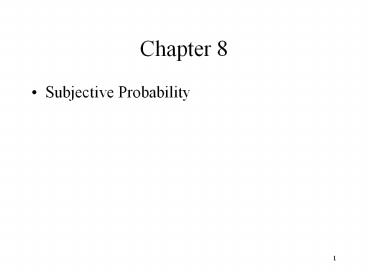Subjective Probability PowerPoint PPT Presentation
Title: Subjective Probability
1
Chapter 8
- Subjective Probability
2
Chapter 8, Subjective Probability
- Learning Objectives
- Uncertainty and public policy
- Subjective probability-assessment technique
- Heuristics and Biases
- Experts and Probability Assessment
3
Chapter 8,Subjective Probability
- Subjective assessments of uncertainty are an
important element of decision analysis. - In modern decision analysis subjective judgments
of uncertainty can be made in terms of
probability. - Need to develop a approach to measure the
uncertainty that we feel
4
Uncertainty and Public Policy
- Fruit Frost, Farmers occasionally must decide
whether to protect a crop from potentially
damaging frost. - Decision must be made in terms of probability
- Earthquake Prediction, Geologists are beginning
to develop ways to assess the probability of
major earthquakes.
5
Uncertainty and Public Policy
- Environment Impact Statements
- Require assessments of the risks assessments of
the risks associated with proposed projects. - Projects involving pesticides and herbicides, the
chances of cancer and other health risks are
assessed.
6
Uncertainty and Public Policy
- Public Policy and Scientific Research
- Scientists learn of the possible presence of
conditions that may require action by the
government. - Medical Diagnosis
- Many physicians in hospital intensive-care units
(ICUs) have access to a complex computer system
known as APACHE III.
7
Uncertainty and Public Policy
- APACHE III (Acute Physiology, Age, and Chronic
Health Evaluation). - APACHE III evaluates the patients risk as a
probability of dying either in the ICU or later
in the hospital.
8
Assessing Discrete Probabilities
- There are three basic methods for assessing
discrete probabilities - The first is to have decision maker assess the
probability directly - What is your belief regarding the probability
that event such and such will occur?
9
Assessing Discrete Probabilities
- The second method is to ask about the bets that
the decision maker would be willing to place - The third approach adopts a thought-experiment
strategy - Decision maker compares two lotterylike games,
each of which can result in a prize.
10
Assessing Discrete Probabilities
- Third method approach
- We would ask the decision maker to compare the
lottery
Win prize A if the Lakers win
Win prize B if the Lakers lose
With the lottery
Win prize A with known probability
p. Win prize B with probability 1-p.
11
Assessing Continuous Probabilities
- Apply the technique of assess individual
probabilities and then use these to plot a rough
CDF. - The easiest way to use a continuous distribution
in a decision tree or influence diagram is to
approximate it with a discrete distribution.
12
Pitfalls Heuristics and Biases
- Heuristics can be thought of as rules of thumb
for accomplishing tasks. - They are easy and intuitive ways to deal with
uncertain situations - It takes considerable practice before one is
comfortable making probability assessments.
13
Heuristics and Biases
- Representatives judge the probability that
someone or something belongs to a particular
category. - Availability judge the probability that an event
will occur according to the ease with similar
events from memory. - Traffic accident and fire
14
Heuristics and Biases
- Motivational Bias Incentives often exist that
lead people to report probabilities that do not
entirely reflect their true beliefs. - Awareness of the heuristics and biases may help
individuals make better probability assessments.
15
Experts and Probability Assessment
- In complex problems, expert risk assessment plays
a major role in the decision-making process. - The procedures for acquiring expert probability
assessment has been established. - Every assessment protocol should include the
following steps - Background
16
Experts and Probability
- Background The first important step
- Identification and recruitment of experts
- Motivating Experts
- Structuring and Decomposition, this step
identifies specific variables for which judgments
are needed. - Probability-Assessment training
17
Experts and Probability
- Probability Elicitation and Verification, in this
step the experts make the required probability
assessment. - As part of this process, an expert may provide
detailed chains of reasoning for the assessments. - Aggregation of Experts Probability Distribution
18
Subjective probability
- Constructing Distribution using RISKview
- Step 1 through 8
19
Chapter 8, Subjective Probability
- Summary
- Build model using subjective probability-assessmen
t - Continuous and discrete probability assessing
- Pitfalls and Heuristics
- Expert probability assessment

